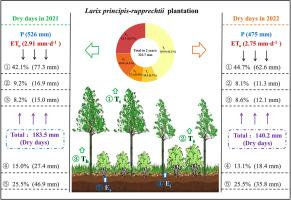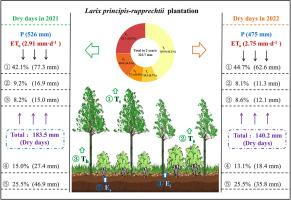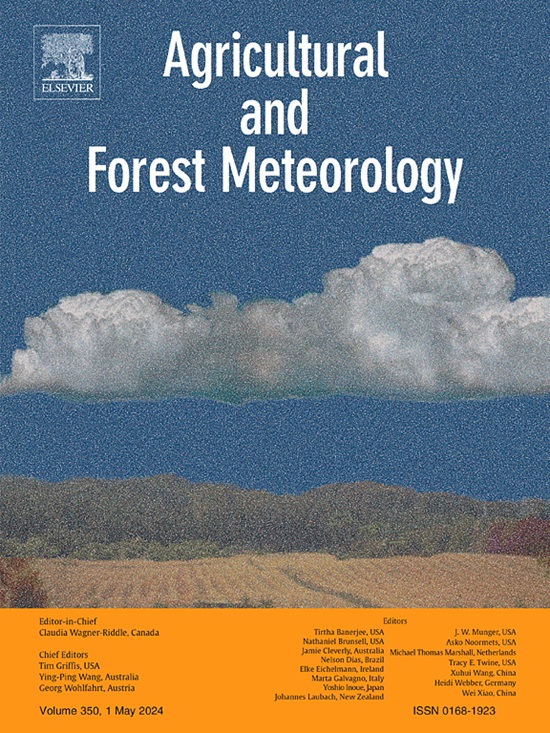Distribution of evapotranspiration components along vertical layers and their controls in dry days of larch plantation in the Liupan Mountains of northwest China
IF 5.7
1区 农林科学
Q1 AGRONOMY
引用次数: 0
Abstract
Precise quantification of forest evapotranspiration (ETf) including transpiration from tree (Tt), shrub (Ts), and herb (Th) layers, as well as evaporation from litter (El) and soil (Es) layers, and elucidating their responses to environmental conditions and stand structures are crucial for forest water management in water-limited forests. In this study, we observed the Tt, Ts, Th, El, and Es, reference evapotranspiration (ETo), soil volumetric water content (SWC), litter water content (LWC), leaf area index (LAI) in tree, shrub, and herb layers, and canopy shade (Ksc) from tree layer of the Larix principis-rupprechtii plantation during the dry days from May to October of 2021 and 2022 to elucidate the distribution of evapotranspiration along vertical layers and their environmental and structural determinants. The results indicated that the contributions of Tt, Ts, Th, El, and Es to ETf during the dry days in 2021 (2022) were 42.1 % (44.7 %), 9.2 % (8.1 %), 8.2 % (8.6 %), 15.0 % (13.1 %), and 25.5 % (25.5 %), respectively. Although Tt and Ts demonstrated quadratic relationships with ETo, Th, El, and Es exhibited linear relationships. All ETcs demonstrated a saturated exponential relationship with either SWC or LWC. Furthermore, Tt, Ts, and Th showed a saturated exponential relationship with their respective LAI, whereas El and Es exhibited a cubic relationship with LAI in tree layers. All understory ETcs (Ts, Th, El, and Es) decreased exponentially with the Ksc. The multi-factor models of evapotranspiration component (ETc) from different vertical layers, which coupled the impacts of environmental conditions and vertical structure, were developed, and provided superior accuracy (R2 = 0.78–0.88, NSE = 0.78–0.86, RSME = 0.03–0.16). Such insights deepened the understanding of vertical structural distribution and multi-factor responses of ETcs in forest ecosystems and hold the potential to inform and optimise forest water management strategies.


中国西北部六盘山落叶松种植园干旱天垂直层蒸散分量的分布及其控制因素
精确量化森林蒸散量(ETf),包括乔木层(Tt)、灌木层(Ts)和草本层(Th)的蒸散量,以及枯落物层(El)和土壤层(Es)的蒸发量,并阐明它们对环境条件和林分结构的响应,对于水资源有限的森林的水分管理至关重要。在这项研究中,我们观测了乔木层、灌木层和草本层的 Tt、Ts、Th、El 和 Es、参考蒸散量(ETo)、土壤容积含水量(SWC)、枯落物含水量(LWC)、叶面积指数(LAI)、在 2021 年和 2022 年 5 月至 10 月的干旱日期间,研究人员通过对 Larix principis-rupprechtii 种植园乔木层的蒸散量(ETo)、土壤容积含水量(SWC)、枯落物含水量(LWC)、乔木层、灌木层和草本层的叶面积指数(LAI)以及冠层遮荫度(Ksc)进行分析,以阐明蒸散量在垂直层间的分布及其环境和结构决定因素。结果表明,在2021年(2022年)的干旱天,Tt、Ts、Th、El和Es对蒸散发的贡献率分别为42.1%(44.7%)、9.2%(8.1%)、8.2%(8.6%)、15.0%(13.1%)和25.5%(25.5%)。虽然 Tt 和 Ts 与 ETo 呈二次方关系,但 Th、El 和 Es 呈线性关系。所有 ETcs 都与 SWC 或 LWC 呈饱和指数关系。此外,Tt、Ts 和 Th 与各自的 LAI 呈饱和指数关系,而 El 和 Es 与树木层的 LAI 呈立方关系。所有林下蒸散发(Ts、Th、El 和 Es)都随 Ksc 呈指数下降。结合环境条件和垂直结构的影响,建立了不同垂直层蒸散分量(ETc)的多因素模型,并提供了较高的精度(R2 = 0.78-0.88,NSE = 0.78-0.86,RSME = 0.03-0.16)。这些见解加深了对森林生态系统中 ETcs 垂直结构分布和多因素响应的理解,并有可能为森林水资源管理策略提供信息和优化。
本文章由计算机程序翻译,如有差异,请以英文原文为准。
求助全文
约1分钟内获得全文
求助全文
来源期刊
CiteScore
10.30
自引率
9.70%
发文量
415
审稿时长
69 days
期刊介绍:
Agricultural and Forest Meteorology is an international journal for the publication of original articles and reviews on the inter-relationship between meteorology, agriculture, forestry, and natural ecosystems. Emphasis is on basic and applied scientific research relevant to practical problems in the field of plant and soil sciences, ecology and biogeochemistry as affected by weather as well as climate variability and change. Theoretical models should be tested against experimental data. Articles must appeal to an international audience. Special issues devoted to single topics are also published.
Typical topics include canopy micrometeorology (e.g. canopy radiation transfer, turbulence near the ground, evapotranspiration, energy balance, fluxes of trace gases), micrometeorological instrumentation (e.g., sensors for trace gases, flux measurement instruments, radiation measurement techniques), aerobiology (e.g. the dispersion of pollen, spores, insects and pesticides), biometeorology (e.g. the effect of weather and climate on plant distribution, crop yield, water-use efficiency, and plant phenology), forest-fire/weather interactions, and feedbacks from vegetation to weather and the climate system.

 求助内容:
求助内容: 应助结果提醒方式:
应助结果提醒方式:


